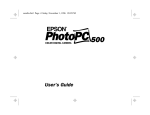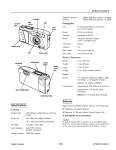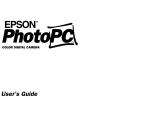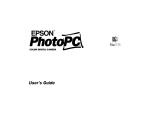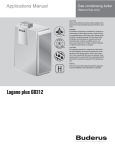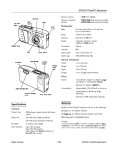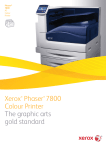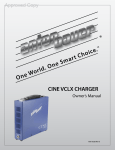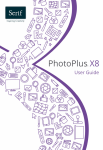Download Epson A882401 Specifications
Transcript
EPSON PhotoPC 500 viewfinder Specifications flash light red timer sensor light \n - a/ Technical poti Product type CCD (charge coupled device) still frame camera Image size 640 x 480 pixels (high resolution) 320 x 240 pixels (standard resolution) 16 million colors, 24-bit cover Bit depth Serial interface power switch viewfinder Internal memory / lens optional expansion shutter button / control panel \ I green ready light battery cover lock / hand strap holder battery cover / 2MB (0.5MB flash memory x 4 chips) 4MB (0.5MB flash memory x 8 chips) memory Photographic Lens Focus distance = 6 mm (equivalent to a 43 mm lens on a 35 mm film camera) Range 2 ft (60 cm) to infinity 8 in. (20 cm) to infiity (Macro mode with optional EPSON PhotoPixTM LCD Monitor) Exposure Equivalent to ISO 130 Shutter Automatic electronic shutter, l/30 to 1/10,000 second Viewfinder Optical Aperture F2.8/8 automatic change Flash modes Automatic, red-eye reduction, flash off, forced flash Flash range 1.5 ft to 10 ft (0.45 m to 3 m) LCD ilnlet cover red standby light 8-pin DIN (camera); Rs232C (Windows); 8-pin DIN (Macintosh) with cable adapter for RS232C interface 2MB flash memory (0.3MB used for program memory) Physical Dimensions Width 5.59 in. (142 mm) Height 3.19 in. (81 mm) Depth 2.09 in. (53 mm) Weight 0.66 lb. (300 g) without batteries Power port cover Sources 4 AA batteries (single-use alkaline, singleuse lithium, rechargeable NiCad, or rechargeable Ni-MH) Optional AC adapter 03867027) Digital Camera 10/96 EPSON PhotoPC 500 - 1 EPSON PhotoPC 500 Consumption Approximately 100 milliwatt at power-on Checking the Battery Icon Approximately 4 W during image processing Before you take pictures, check the battery icon on the control panel. The icon shows how much battery power you have left, in the following stages: Maximum 12 W during flash discharge Battery life Approximately 300 pictures (high resolution) can be taken before the batteries run out. (Using new alkaline batteries, 150 flashed and 150 non-flashed pictures, without the EPSON PhotoPix LCD monitor attached). Batteries TM Replace all four PhotoPC following: 500 batteries with any of the Full battery power (or AC adapter in use) @Em t0 Battery power is decreasing irih Ir Battery power is low n Battery power is almost out ;lzg Change batteries 0 Single-use AA alkaline batteries* Cl Single-use AA lithium batteries (longest battery life) Cl Rechargeable AA Ni-Cad batteries 0 Rechargeable AA Ni-MI-I batteries Installing Batteries Follow these steps to install batteries: Make sure the camera is off, then locate the battery cover on the bottom of the camera. * If you have the PhotoPix LCD monitor, rechargeable or lithium batteries are recommended. Using your fingernail or a small screwdriver, slide the battery cover lock down in the die&ion of the arrow and hold it in that position while pulling the battery cover door open. Caution To avoid the &anger qfjire OY explosion, do not mix different types ofbatteries. Do not allow the battery contacts to touch metal objects such as coins OY keys, which could short out the battery’s circuits. Insert all four batteries into the compartment, positioning them as shown. Note the following when handling batteries: Q Do not use manganese batteries. 0 Replace all four batteries at the same time. 0 Do not drop, puncture, disassemble, or mutilate batteries. Do not get them wet or expose them to fire. Cl When the camera is not used for long periods of time, remove the batteries and store them at a low temperature in a dry location. 0 Dispose of used batteries according to the battery manufacturer’s instructions and in compliance with all applicable laws. Contact your local government agency for information about battery recycling and disposal. Q If you use rechargeable Ni-Cad batteries, replace them with four fully-charged batteries. If your batteries run out faster after you recharge them a number of times, make sure you discharge them completely before recharging. EPSON PhotoPC 500 - 2 4. Close the battery cover, making sure that it snaps in place. 10/96 Digital Camera EPSON PhotoPC 500 Resolution The Control Panel The PhotoPC 500 has the following two resolution settings: The control panel keeps track of how many pictures have been taken. It also gives important information about the status of the battery and various settings. pictures taken resolution mode \ I Hi S erase last /picture High resolution images are captured at 640 x 480; the camera can hold up to 30 pictures at high resolution. This is the factory setting. Standard resolution images are captured at 320 x 240; the camera can hold up to 60 pictures at this resolution. Timer The timer sets a lo-second delay between the time the shutter button is pressed and the image is captured. timer battery level flash mode Erase Press the erase button with a small pointed object to erase the last picture from the camera’s memory. The Control Buttons You can adjust the following settings using the control buttons on the top of the camera: 0 Flash 0 Resolution CI Timer. You can also erase the last picture from the camera’s memory. Flash and resolution settings remain in effect even after you turn off the camera. However, they return to their factory settings when you remove or change the batteries. Connecting the Camera to a PC Follow these steps to connect the camera to a PC to transfer pictures: 1, Press on the arrows on the camera’s port cover and slide up the cover. (If you have an EPSON PhotoPix LCD monitor attached to the camera, tilt it up to expose the port cover.) 2. Line up the arrow on the cable connector with the notch on the camera’s serial port, as shown. Insert the connector. Flash The built-in flash has these four settings, which are effective within a range of 3 to 10 feet: AUTO 4 @ 0 5 Auto sets the flash to go off automatically whenever it’s needed (factory setting). Red-eye reduction sets the flash to blink rapidly while the picture is being taken. This prevents the subject’s eyes from appearing red. Flash off disables the flash even in inadequate lighting. Forced flash sets the flash to go off for every picture. 3. Connect the other end of the cable to one of the computer’s serial ports and tighten the retaining screws. 4. Turn on the camera and the computer system. A line appears at the bottom of the picture counter on the camera’s control panel. Note: When the camera is connected to the PC, you cannot use the shutter button or any of the control buttons. Digital Camera 10/96 EPSON PhotoPC 500 - 3 EPSON PhotoPC 500 Use the EPSON PhotoPC 500 imaging software and the EPSON Photo! TWAIN and Utility Driver to transfer pictures to the PC; see the EPSON PhotoPC 500 User’s Guide for Windows for instructions. DB9 Note: EPSON Photo! Twain and Utility Driver automatically chooses the fastest speed that works with your operating system. If you get an ~YYOY message when you try to download photos to the PC, the camera’s port speed may befaster than the port speed configured for your PC. You can configure the camera for any of the following port speeds: 115,200 (Windows 95 and NT) 57,600 38,400 19,200 Attach to \ Attach to computer Photo PC 500 cable DB9 connector Connecting the Camera to a Macintosh 4. Connect the other end of the Mac adapter cable to either the printer port or the modem port on your Macintosh. Follow these steps to connect the camera to a Macintosh to transfer pictures: 5. Turn on the camera and the Macintosh system. A line appears at the bottom of the picture counter on the camera’s control panel. 1. Press on the arrows on the camera’s port cover and slide up the cover. (If you have an EPSON PhotoPix LCD monitor attached to the camera, tilt it up to expose the port cover.) 2. Locate the Photo PC 500 cable. Line up the arrow on the cable connector with the notch on the camera’s serial port, as shown. Insert the connector. Note: When the camera is connected to the Macintosh, you cannot use the shutter button or any of the control buttons. Use EPSON PhotoPC 500 imaging software and the EPSON Photo! TWAIN and Utility Driver to transfer pictures to the Macintosh; see the EPSON PhotoPC 500 User’s Guide for Macintosh for instructions. Note: EPSON Photo! Twain and Utility Driver automatically chooses the fastest speed that works with your operating system. If you get an ~YYOY message when you try to download photos to the Macintosh, the camera’s port speed may be faster than the port speed configured for your Macintosh. You can configure the camera $Y ax;6$;hejbllowing port speeds: 38:400 19,200 3. Attach the DB9 connector on the Photo PC 500 cable to the DB9 connector on the Mac adapter cable; tighten the screws. EPSON PhotoPC 500 - 4 10/96 Digital Camera EPSON PhotoPC 500 The EPSON PhotoPix LCD monitor allows you to view images in two modes: Maintenance Care for the EPSON PhotoPC 500 and PhotoFix LCD monitor as follows: Cl Use a clean, dry cloth to keep the camera and PhotoFix LCD monitor free of dust. If you are cleaning the camera lens, blow off any loose dust, then breathe on the lens and wipe off the moisture with a soft, lint-free cloth or lens cleaning tissue. Cl Avoid pressing too hard on either the lens or the LCD display. Lets you view images that you have already captured. Use to locate images, select and erase images, etc. Lets you preview in real time what the View Mode camera’s viewfinder sees at any moment. Use to fine-tune pictures (for example, adjust the position of the camera). Set Playback Mode or View Mode from controls on the front of the monitor. Playback Mode 0 If necessary, clean the camera’s battery contacts with a dry cloth. Cl Do not use harsh abrasive cleaners. Cl Cover the lens (power switched off) when you are not using the camera. Cl Remove the LCD monitor from the camera when you are traveling with it, or when you are not using it for long periods. Cl When the LCD monitor is not attached to the camera, make sure that it is switched off and that the LCD inlet cover is attached. In storage, do not expose the PhotoPC 500 or the PhotoPix LCD monitor to the following: D Direct sunlight, bright light sources, or heat sources (such as a closed car) The following controls are on top of the PhotoPix LCD monitor: P Excessive dust, dirt, humidity, strong vibrations, or magnetic fields. Macro Optional PhotoPix LCD Monitor Physical Dimensions Width 5.08 in (129 mm) Height 2.72 in (69 mm) Depth 1.97 in (50 mm) Weight 0.31 lb (141 g) Multi Plus/Minus Use to take close-up pictures. You can capture an image as close as 8 inches from the subject. You must set the monitor to View mode before selecting Macro. Use to view thumbnail versions of multiple images at the same time. Multi mode is available when the monitor is in Playback mode. Use to adjust the LCD’s brightness when the monitor is in View mode, or to flip through the images in memory when the monitor is in Playback mode. Technical LCD Panel 1.8 in, TFT color LCD Display resolution 279 x 220 pixels Power for the PhotoPix LCD monitor is supplied by the camera. For a detailed explanation of how to use these features, see the EPSON PhotoPC 500 User’s Guide. Digital Camera 10/96 EPSON PhotoPC 500 - 5 EPSON PhotoPC 500 Attaching the Optional PhotoPix LCD Other Optional Accessories Follow these steps to attach the optional EPSON PhotoPix LCD monitor to the camera: You can increase the camera’s storage capacity by installing a 2MB or 4MB PhotoSparP memory module, as described in this table: Make sure your camera is turned off. Set the PhotoPix LCD monitor’s mode switch to the OFF position. Pressing on the arrow on the LCD inlet cover with your thumb, slide the cover away from the camera. (Put the cover in a safe place.) Number of photos At high resolution At standard resolution 2MB internal memory 30 60 With 2MB PhotoSpan A882401 65 130 With 4MB PhotoSpan A882411 100 200 Position the PhotoPix LCD monitor beside the camera. The display should be facing you. See the EPSON PhotoPC 500 User’s Guide for instructions on installing a PhotoSpan module. While holding the camera with one hand, carefully slide the LCD connector into the LCD inlet. Make sure it is firmly in place. You can connect the PhotoPC 500 to a standard electrical outlet using the AC adapter (B867027) to save power when transferring pictures to the Macintosh or PC, or operating the camera from either system. The adapter does not charge the camera’s batteries. LCD corm Optional 37mm video camcorder lenses or filters may also be used for taking close-up, wide-angle and special effects pictures. To attach a lens, screw it on the camera as shown: Detaching the Optional PhotoPix LCD Follow these steps to detach the PhotoPix LCD monitor from the camera: 1. Turn the camera off, and set the PhotoPix LCD monitor’s mode switch to OFF. 2. Place the camera on a flat surface with the back facing you. 3. Holding the camera with your right hand, use your left thumb to press the release button on the LCD connector. release Installing a PhotoSpanTM Memory Module Before you install a PhotoSpan memory module, make sure you download all the pictures in the camera to the computer, then erase them from the camera and turn the camera off. CAUTION: PhotoSpan modules are sensitive to static electricity and easily damaged. Ground yourself by touching a metal object before you handle the module, and never touch the module’s metallic area. Follow these steps to install a PhotoSpan module: 1. Slide the memory module cover lock down to release the cover. 4. While holding down the button, carefully push the PhotoPix LCD monitor away from the camera; do not pull the monitor. 5. Replace the LCD inlet cover on the back of the camera. EPSON PhotoPC 500 - 6 10/96 Digital Camera EPSON PhotoPC 500 The number on the control panel indicating pictures remaining increases to show your camera’s expanded capacity. With the expanded memory, you may notice a delay between the time you press the shutter button and when the camera beeps. To reduce this delay, press the button down halfway until you are ready to take the picture, then press it down the rest of the way. 2. Grasp the cover and pull away. Removing a PhotoSpan Memory Module Follow these steps to remove the memory module: CAUTION Do not remove and install the module repeatedly. Doing so may cause a bad connection or may damage the memory module. Turn the camera off and remove the memory module cover. Press the lever on the side of the memory module socket to raise the module slightly out of the socket. 3. Place the module into the socket, as shown below. Align the side of the module that has two notches with the socket end nearest the small black lever. (See the illustration under “Removing a PhotoSpan Memory Module” for the location of the lever.) Grasp the edges of the memory module and work it up and out of the socket. Be careful not to touch the metal parts of the module. 4. Press down on the module until it snaps into the retaining clips at the side of the socket. Do not force the module. If it does not seem to fit, make sure that you have inserted it correctly. Replace the memory module cover. 5. Replace the cover on the camera body. It should snap into place. Digital Camera 10/96 EPSON PhotoPC 500 - 7 EPSON PhotoPC 500 Information Reference List Engineering Change Notices None. Product Support Bulletins None. Technical Support Bulletins None. Related Documentation CPD4185 PhotoPC 500 User’s Guide for Windows CPD4186 PhotoPC 500 User’s Guide for Macintosh EPSON PhotoPC 500 - 8 10/96 Digital Camera








